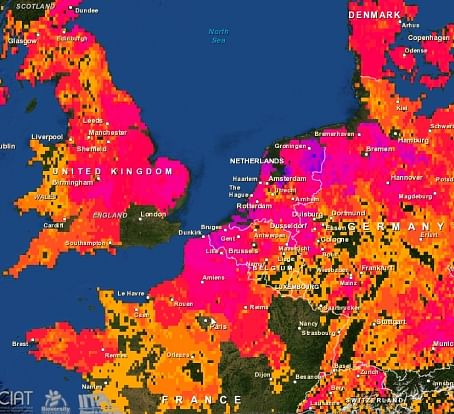NEPG (North-Western European Potato Growers)
主标签
2013 potato crop area estimates and progress in North-Western Europe

The North-Western European Potato Growers (NEPG) has issued an updated estimate of planted area for the 2013 crop (at the start of July).
Based on first estimates and survey work the NEPG reports the total estimated planted area, excluding seed and starch potatoes, across the five main countries at 530,000 hectares, see table 1.
This is an increase of 3.8% on last season.
However it should be noted that the area fell by 6% between 2011 and 2012 so the area is returning to more usual levels.
Should yields this season be in line with the last five year average, this could result in a harvest of 24 million tonnes, an increase of almost 10% on last year’s crop. However while the crop is still growing it is too early to estimate the average yield for this year as it is dependent upon the growing conditions during the rest of the summer.
While all NEPG countries have seen an increase in estimated planted area for fresh potatoes, Belgium is forecast the largest increase,11.8% or 12,000 hectares larger than last year. According to the Belgian NEPG members, the increase in area is being driven by higher contract prices, resulting in an increase in contract numbers, and at the same time an increase in demand from potato processors. Belgium has now become the largest processor in the world and has doubled their need for raw processing material over the last 10 years. The entrance of new potato growers to the market in Belgium is also noted as contributing towards the increased area.

Table 1: NEPG planted area estimate in hectares (excluding seed and starch and figures to the nearest thousand)
The NEPG release also highlights that, on the continent, the majority of NEPG countries had used up old crop supplies with the result that processors may start sooner and, in doing so, extend the 2013/14 supply season. However this demand for new crop material may start at a time when new crops have not reached maturity and weight which would put pressure on supplies. Both Belgium and the Netherlands process more potatoes than they produce, with the need to import supplies.

Illustrative geographic potato cultivation distribution in this part of the world, ~2000 (CGIAR)
Crop Progress
---->Note: originally published July 30
The growing conditions this summer are particularly important to final crop performance. Potato production in Great Britain has faced continuing challenges in recent weeks. At the start of July crops were generally reported to be progressing well under welcome warm, sunny conditions interjected with some beneficial rain. As the month progressed, however, there were only light showers resulting in an increased need for irrigation, although not always available. The dry warm conditions were beneficial to dry matters and also blight control. However more recently, non-irrigated crops have suffered, with some at the point of wilting, displaying signs of stress and even early senescence. Crop condition is varied dependent on region, soil type and whether irrigation is available, but in general crop health was reported as good.
The situation in Belgium, Netherlands, France and Germany the situation is very similar to GB with extreme dry weather conditions also reported, and no short term let up expected, with the result that lower yields are anticipated.
In Belgium, most of the potato producing areas are said to be too dry which, according to Phaff Export Marketing, is impacting on the growth of early processing crops, said to be lacking in tuber size. During the second week of July first harvests of 25-35t/ha were reported, though many factories were still shut down for the season change over. By the third week of July it was reported that dry matters were improving. More recently dry conditions have been reported, which often prove challenging harvest condition although the West had some heavy showers this week. Trial harvests for earlies suggest yields of 32t/ha compared with 36t/ha for the 6 year average.
In France, Phaff Export Marketing report that irrigation activity is taking place due to the dry conditions, though, in the last week, they report that there are some restrictions in place in some parts of the country. A delay in crop development, and therefore harvest, of two to three weeks is still reported with slow tuber development, although the crop is said to be looking healthy with a good canopy.
In the Netherlands the crop has been growing well, according to Phaff Export Marketing, athough conditions are dry and full irrigation is in use. While on clay soils the concern of the dry weather is less pronounced, on light soils, especially without irrigation, the crop is suffering in the warm, dry weather and the rate of growth is reported to be slow. Yields are anticipated to be lower than normal.
In Germany, according to Phaff Export Marketing, the harvest of fresh potatoes has been progressing well. A lack of large tubers is noted, and due to the drought, both the early and main crops are said to be growing slowly, and not looking healthy in some areas. Due to the unfavourable weather conditions, overall lower yields than usual are anticipated. According to the Statistical Bureau, the total German harvest is estimated at 10.2 million tonnes, which is 500,000 tonnes less than last year. Lower Saxony, the largest potato producing region, with almost half of the usual total potato harvest, has a smaller potato area of 101,464 hectares, 2.1% less than last year.
Harvesting of early processing material is now reported and crisping and peeling companies are said to be keen to secure new crop supplies. According to Phaff Export Marketing, it is expected that some factories will make a start on first contracts with current stocks low. It is anticipated that newly harvested German material will soon feature as the main fresh retail produce, replacing imported Israeli, Portugese and Egyptian supplies.







